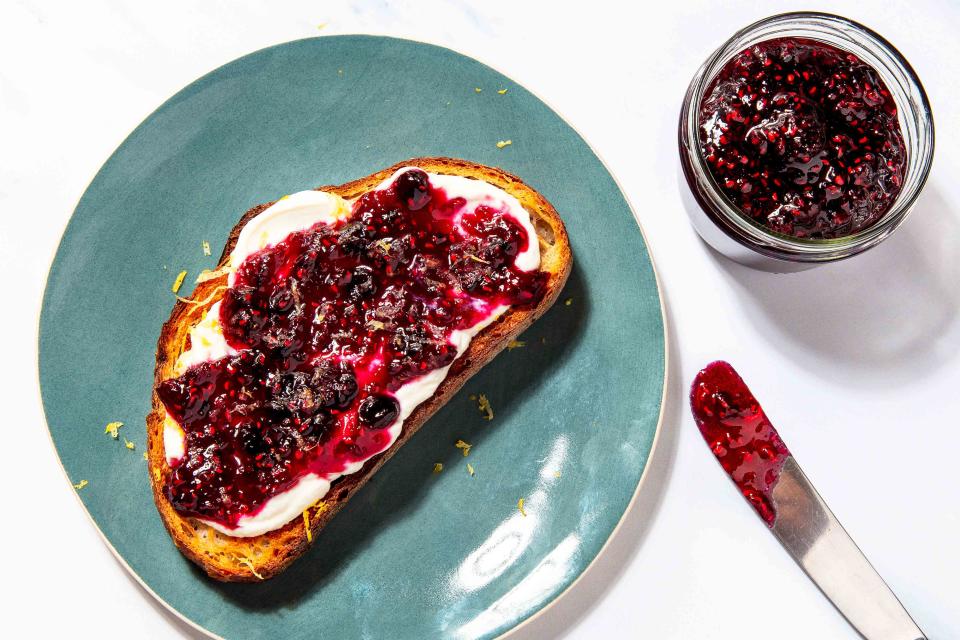Why I Make Jam
This cooking tradition gave me a sense of place and created a community when I needed it most.

Matt Taylor-Gross / Food Styling Debbie Wee
My first time was kind of a disaster.
It’s the summer of 2007. My husband and I are newly married and out in the Northwest visiting friends. I’m with two other canning virgins in Port Angeles, Washington, where my friend Kate lives.
One afternoon, we decide to make mixed berry jam. (We’re in bramble country, after all, where folks know a marionberry from a tayberry.) Kate pulls out a big kettle. We head to the thrift shop and the hardware store for jars and lids. We suit up with aprons and bandannas. Kate reads out loud the directions from an old-timey preserving book. We have absolutely no idea what we are doing, but we press on.
There is lots of red wine, merriment, and Donna Summer on the turntable. The jam is fine, if not overly sweet from too much added sugar. It takes forever to get it to gel. The real buzzkill: Very few of our jars actually seal to make them shelf-stable. There wasn’t much jam to be proud of.
A few years later, my husband and I are living in Seattle, and I still have a canning itch to scratch. I want to get it right – the jar-sealing part, for starters – but I also want to understand where we went wrong and why our jam was so runny on that maiden voyage. I want to learn the steps from start to finish and see if I actually like preserving, if it has any practical value for this middle-aged newbie.
I hardly know anyone in my new town, so I go to Twitter in search of kindred spirits. There are so many preserving wannabes I can hardly contain myself. We gather, we call ourselves Canning Across America. We are writers, chefs, gardeners, cookbook authors, knitters, astrologers. We set up a website and begin teaching each other the basics of water-bath canning. How to put summer in a jar — and how to do it safely.
Over the next three years, we go out into the community, teaching others how to make jam at farmers markets and community gardens. We yuk it up and forge friendships. We get really good at this canning thing. We are determined not to let this life skill miss another generation, as it had ours.
It was one of the happiest times in my life. Canning asks for your full attention and to be in the moment – with the produce, with the process, and with your fellow canners. You need to put that phone down to get the job done – and that is a beautiful thing.
In that first year, our enthusiasm was insatiable, our canning choices indiscriminate; after all, we needed the practice. We turned apricots into mustard, cherries into ketchup, plums into moo shu dipping sauce.
By the next spring, I did an honest inventory of my ambitions and my pantry. I had become a maven of condiments, most of it unused. I learned to edit my preserving wish list and focus on the goods I knew I’d really use: Pickles of carrots, cucumbers, and jalapeños. Salsa verde made from tomatillos. Jams but not fruit butters. Peaches for barbecue sauce (but not halved in syrup). And enough crushed tomatoes or marinara sauce to get us through the winter. (About 12 quarts, if anyone is asking.)
I am one of those people with a wooden “jelly” cabinet, its three shelves groaning with jars every September. I never tire of opening its screened door to survey my handiwork, grab a jar for dinner or a snack plate or give to a friend just because.
More recently, my canning practice informs my garden. I grow enough dill to infuse cucumber and green bean pickles, and also tomatillos, because none of my local farm stands grows enough for my salsa needs. I may have come late to canning, but I’m making up for lost time. I’ll do it until my time here is done. It’s practical magic unlike any other.
For more Food & Wine news, make sure to sign up for our newsletter!
Read the original article on Food & Wine.

